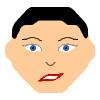  The only difference: the mouths, which are asymmetrical. The top face is regarded as happier by the vast majority of right-handers (and most left-handers). Human faces are identified by the brain's right hemisphere, so the mouth's left corner is focused upon. This is a typical example of hemispheric lateralization.
Above are two images of Margaret Thatcher, each turned upside-down. But one of them is a horrific monster! Which is it -- A or B? It's hard to tell, because your brain is globally scanning them. To see each picture as "rightside-up," click each one to view it on another page. The person below is apparently two-faced, because your brain cannot settle on a stable interpretation...  Get a grip on yourself. If your hands are configured as below, and then tapped in rapid succession, you'll have difficulty in determining which is tapped first. Perform this experiment while sober.  An astounding optical illusion. Squares A and B are equal in shade. If the accompanying image fails to prove it, then print out a hard copy of the original. Cut into squares and compare.   Artist: Edward H. Adelson Escalator Illusion. Next time at the mall, if you happen to spot a broken escalator, try walking up on it. Be warned, though, that you risk falling. Past escalator experience has dictated a set of unconscious expectations. Trekking up a stalled escalator, you may feel as if you're being "sucked" onto it. It's a moving experience! Some material above excerpted from Mind Hacks, by Tom Stafford and Matt Webb. Links to Other Sites |

